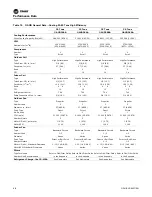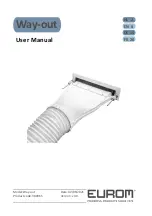
Startup
OAU-SVX005C-EN
33
frequency fluctuations of ±10 percent during any part of
the operating sequence. The initiate sequence lasts for
10 seconds unless the voltage or frequency tolerances are
not met. When not met, a hold condition is initiated and
displayed on the optional KDM for at least five seconds.
When met, the initiate sequence restarts. If the condition is
not corrected and the hold condition exists for 4 minutes,
the flame relay module locks out.
Causes for a hold condition in the initiate sequence are as
follows:
•
AC line dropout detection.
•
AC line noise that can prevent a sufficient reading of
the line voltage inputs.
•
Low line voltage brownouts.
Standby
The flame relay module is ready to start an operating
sequence when the operating control input determines a
call for heat is present. The burner switch, limits, operating
limit control and all microcomputer-monitored circuits
must be in the correct state for the relay module to
continue into the “pre-purge” sequence.
Normal Start-up Pre-purge
The module provides 30-second ”pre-purge” timing with
power applied and the operating control indicating a call
for heat.
•
The airflow interlock, burner switch, and all
microcomputer-monitored circuits must also be in the
correct operating state.
•
The pre-purge sequence begins on call for heating.
•
Failure to establish airflow at unit airflow proving
switch within 15 seconds of indoor fan enable
discontinues ignition.
Ignition Trials
The pilot flame establishing period (PFEP) begins when:
•
The pilot valve and ignition transformer, terminals 8
and 10, are energized. The RM7895A/B, EC7895A, and
RM7896A/B modules have an intermittent pilot valve,
(terminal 8). The RM7895C/D, EC7895C, and RM7896C/
D modules have an interrupted pilot valve (terminal 8).
•
Flame must be proven by the end of the 15-second
PFEP (4 seconds if configuration jumper, JR1, is
clipped) to allow the sequence to continue. If a flame is
not proven by the end of PFEP, a safety shut down
occurs.
With flame proven, the ignition, terminal 10, is energized.
This main flame establishing period (MFEP) begins when:
•
After ignition trials, and with the presence of flame, the
main fuel valve, terminal 9, is powered. If a flameout
occurs, the relay module locks out or recycles
(depending on status of jumper JR2) within 0.8 or
3 seconds, depending on the flame failure response
time (FFRT) of the amplifier.
•
The RM7895C/D, EC7895C, and RM7896C/D modules
have a 10-second MFEP. After ignition trials and with
the presence of flame, the main fuel valve, terminal 9,
is powered. If the flameout occurs, the relay module
locks out within 0.8 or 3 seconds, depending on the
amplifier FFRT.
Run
The RM7895C/D, EC7895C, RM7896C/D has a delayed
main valve that is energized once the “run” period is
entered.
The relay module is now in “run” and remains in “run”
until the controller input, terminal 6, opens, indicating that
the demand is satisfied or a limit has opened.
Run/Test Switch (RM7895C/D, EC7895C, RM7896C/
D only)
The “run/test switch” is located on the top side of the relay
module. This switch allows the burner sequence to be
altered as follows:
•
In the measured “pre-purge” sequence, the “run/test
switch,” placed in the “test” position, causes the
prepurge timing to stop.
•
In the “pilot flame establishing period” sequence, the
“run/test switch,” placed in the “test” position, stops
the timer during the first 8 seconds of a 10-second
PFEP selection, or during the first 3 seconds of a
4-second PFEP.
•
It also allows for pilot turn-down test and other burner
adjustments. This activates a 15-second flameout
timer that permits pilot flame adjustment without
nuisance safety shutdowns. The run/test/switch is
ignored during PFEP for the C and D relay modules if
terminals 8 and 9, or 9 and 21 are jumpered.
Note:
When the relay module is switched to the “test”
mode, it stops and holds at the next run/test switch
point in the operating sequence. Ensure that the
run/test switch is in the “run” position before
leaving the installation.
















































